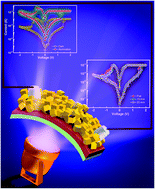Solution-processed light-induced multilevel non-volatile wearable memory device based on CsPb2Br5 perovskite†
Abstract
Despite the recent advancements in memory devices, the quest for building materials with low power consumption is still on, with the ultimate focus on the durability of the system and reliability and reproducibility of its performance. Halide perovskites (HPs), which have several intriguing photoelectrical traits, have recently been utilized for memory applications; one of the highlights of these materials is the ionic-motion-based fast switching in their crystal structure. In this work, a CsPb2Br5 film is applied as a switching layer to implement memory devices with a flexible Al/CsPb2Br5/ITO-PET structure. The device exhibits a pronounced bipolar resistive switching (RS) characteristic at low operating voltage. The as-fabricated flexible device presented RS features with no initial forming process, concentrated distributions of high and low resistance states (HRS and LRS), uniform switching, endurance over 100 cycles, and a long retention time of 103 s with a high on/off ratio of around 102. Multilevel data-storage capability was also observed via subtle control of the compliance current (CC). Considering the current demand for smart, wearable, and flexible electronic gadgets, the current–voltage (I–V) characteristics of the as-fabricated all-inorganic halide-perovskite-based memory device were further explored under different bending conditions to determine its electrical reliability and mechanical stability. This flexible device exhibited no discernible difference in device performance under flat or bent conditions, and the performance remained nearly the same even after 500 bending cycles. In addition to control of the RS effect of the device using an electrical field, the performance of the device under light was also explored. Blue light modulates the resistive states by regulating the condition of photo-generated electron–hole pairs, and the SET and RESET voltages are changed from 2.34 to 2.14 V and from −2.04 to −1.90 V, respectively. The observed RS behavior is explained on the basis of the creation and partial annihilation of conductive multifilaments, which is dominated by the migration of bromine ions and their associated vacancies in the HP layer. We believe that this work will offer a new context to understand the intrinsic characteristics of HPs for RS applications at low voltage and validate their potential in the design of next-generation stable and nonvolatile memory devices for future flexible electronic systems.



 Please wait while we load your content...
Please wait while we load your content...